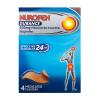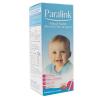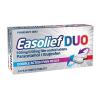Fever
What is it?
- A fever is usually a sign that something out of the ordinary is going on in your body. For an adult, a fever may be uncomfortable, but usually isn't dangerous unless it reaches 103 F (39.4 C) or higher. For young children and infants, a slightly elevated temperature may indicate a serious infection.
- But the degree of fever doesn't necessarily indicate the seriousness of the underlying condition. A minor illness may cause a high fever, and a more serious illness may cause a low fever.
- Usually a fever goes away within a few days. A number of over-the-counter medications lower a fever, but sometimes it's better left untreated. Fever seems to play a key role in helping your body fight off a number of infections.
Symptoms
You have a fever when your temperature rises above its normal range. What's normal for you may be a little higher or lower than the average temperature of 98.6 F (37 C).
Depending on what's causing your fever, additional fever symptoms may include:
- Sweating
- Shivering
- Headache
- Muscle aches
- Loss of appetite
- Dehydration
- General weakness
High fevers between 103 F (39.4 C) and 106 F (41.1 C) may cause:
- Hallucinations
- Confusion
- Irritability
- Convulsions
Fever-induced seizures
A small percentage of children younger than age 5 experience fever-induced seizures (febrile seizures). The signs of febrile seizures, which occur when a child's temperature rises or falls rapidly, include a brief loss of consciousness and convulsions.
Although these seizures can be alarming, most don't cause any lasting effects. Febrile seizures often are triggered by a fever from a common childhood illness such as roseola, a common viral infection that causes a high fever, swollen glands and a rash.
Causes
Your normal body temperature varies throughout the day according to circadian rhythm — it's lower in the morning and higher in the late afternoon and evening. In fact, your normal temperature can range from about 97 F (36.1 C) to 99 F (37.2 C). Although most people consider 98.6 F (37 C) normal, your temperature may vary by a degree or more. Other factors, such as your menstrual cycle or heavy exercise, can affect your temperature.
Here's how body temperature works:
- Your body temperature is set by your hypothalamus, an area at the base of your brain that acts as a thermostat for your whole system.
- Your temperature is the balance of the heat produced by your body tissues, particularly your liver and muscles, and the heat your body loses.
- When you're ill, your normal temperature may be set a few points higher as your body directs blood away from your skin to decrease heat loss.
- When a fever starts and your body tries to elevate its temperature, you feel chilly and may shiver to generate heat until the blood around your hypothalamus reaches the new set point.
- When your temperature begins to return to normal, you may sweat profusely to get rid of the excess heat.If you're very old, very young or alcoholic, your body's ability to produce a fever may be lessened.
A fever usually means your body is responding to a viral or bacterial infection. Other possible causes include:
- Heat exhaustion
- Extreme sunburn
- Certain inflammatory conditions such as rheumatoid arthritis — inflammation of the lining of your joints (synovium)
- Malignant tumor or some forms of kidney cancer (rare)
- Some medications, such as antibiotics and drugs used to treat high blood pressure or seizures
- Some immunizations, such as the diphtheria, tetanus and acellular pertussis (DTaP) or pneumococcal vaccines (in infants and children)
Sometimes it's not possible to identify the cause of a fever. If you have a temperature of 101 F (38.3 C) or higher for more than three weeks and your doctor isn't able to find the cause after extensive evaluation, the diagnosis may be fever of unknown origin.
Complications
A rapid rise or fall in temperature may cause a fever-induced seizure (febrile seizure) in a small number of children ages 6 months to 5 years. Although alarming for parents, the vast majority of febrile seizures cause no lasting effects.
Febrile seizures usually involve loss of consciousness and shaking of limbs on both sides of the body. Less commonly, a child may become rigid and twitch only part of his or her body. If a seizure occurs, lay your child on his or her side or stomach on the floor or ground. Remove any sharp objects that are near your child, loosen tight clothing and hold your child to prevent injury. Don't place anything in your child's mouth or try to stop the seizure. Although most seizures stop on their own, call for emergency medical assistance if a seizure lasts longer than 10 minutes.
Take your child to the doctor as soon as possible after the seizure to determine the cause of the fever.
Diagnosis
Your doctor will look for an infection or noninfectious cause of your fever based on your other symptoms and a physical exam. You may need tests, such as blood tests, to confirm a diagnosis.
If you have a low-grade fever that persists for three weeks or more, but have no other symptoms, your doctor may recommend a variety of tests to help find the cause. These may include blood tests and X-rays.
Treatments and drugs
Treatment depends on the cause of your fever. Your doctor will likely prescribe antibiotics for bacterial infections, such as pneumonia or strep throat.
Antibiotics don't treat viral infections, such as stomach infection (gastroenteritis) and mononucleosis. There are a few antiviral drugs used to treat some specific viral infections. However, the best treatment for most viruses is often rest and plenty of fluids.
Over-the-counter medications
Your doctor may also make a recommendation about using over-the-counter medications, such as paracetamol or ibuprofen to lower a high fever. Adults also may use aspirin. Don't give aspirin to children, however, because it may trigger a rare, but potentially fatal, disorder known as Reye's syndrome.
The downside of lowering a fever
If you have a low-grade fever, it's not advisable to try to lower your temperature. Doing so may prolong the illness or mask your symptoms and make it harder to determine the cause.
Some experts believe that aggressively treating a fever interferes with your body's immune response. The viruses that cause colds and other respiratory infections thrive at normal body temperature. By producing a low-grade fever, your body may be helping eliminate a virus.
Lifestyle remedies
You can try a number of things to make yourself or your child more comfortable during a fever:
- Drink plenty of fluids. Fever can cause fluid loss and dehydration, so drink water, juices or broth. For a child under age 1, use an oral rehydration solution such as Pedialyte. These solutions contain water and salts proportioned to replenish fluids and electrolytes. Pedialyte ice pops also are available.
- Rest. It's necessary for recovery, and activity can raise your body temperature.
- Stay cool. Dress in light clothing, keep the room temperature cool and sleep with only a sheet or light blanket.
- Take paracetamol or ibuprofen. Use according to the label instructions or as recommended by your doctor, and be careful to avoid taking too much. High doses or long-term use of acetaminophen may cause liver or kidney damage, and acute overdoses can be fatal. If you're not able to get your child's fever down, don't give more medication; call your doctor instead. For temperatures below 102 F (38.9 C), don't use fever-lowering drugs unless advised by your doctor.
- Soak in lukewarm water. Especially for high temperatures, a lukewarm five- to 10-minute soak or giving your child a sponge bath can be cooling. Do not use alcohol. And if the bath causes shivering, stop the bath and dry your child. Shivering raises the body's internal temperature — shaking muscles generate heat.
Taking a temperature
To check your or your child's temperature, you can choose from several types of thermometers, including electronic thermometers and ear (tympanic) thermometers. Thermometers with digital readouts and those that take temperature quickly from the ear canal are especially useful for young children and older adults. Because glass mercury thermometers harm both humans and the environment, they have been phased out and are no longer recommended.
Although it's not the most accurate way to take a temperature, you can also use an oral thermometer for an armpit (axillary) reading:
- Place the thermometer in the armpit with arms crossed over the chest.
- Wait four to five minutes. The axillary temperature is slightly lower than an oral temperature.
- If you call your doctor, report the actual number on the thermometer and where on the body you took the temperature.
Use a rectal thermometer for infants:
- Place a dab of petroleum jelly on the bulb.
- Lay your baby on his or her tummy.
- Carefully insert the bulb one-half inch to one inch into your baby's rectum.
- Hold the bulb and your baby still for three minutes.
- Don't let go of the thermometer while it's inside your baby. If your baby squirms, the thermometer could go deeper and cause an injury.
Prevention
The best way to prevent fevers is to reduce your exposure to infectious diseases. One of the most effective ways to do that is also one of the simplest — frequent hand washing.
Teach your children to wash their hands often, especially before they eat and after using the toilet, after spending time in a crowd or around someone who's sick, and after petting animals. Show them how to wash their hands vigorously, covering both the front and back of each hand with soap, and rinsing thoroughly under running water. Carry moist towelettes or hand sanitizer with you for times when you don't have access to soap and water. When possible, teach your kids not to touch their noses, mouths or eyes — the main way viral infections are transmitted.
In addition, teach your children to turn away from others and to cover their mouths when coughing and their noses when sneezing.
References:
https://en.wikipedia.org/wiki/Fever
http://www.emedicinehealth.com/fever_in_adults/article_em.htm
http://www.medicinenet.com/aches_pain_fever/article.htm
https://www.nlm.nih.gov/medlineplus/ency/article/003090.htm
http://kidshealth.org/en/kids/fever.html

















